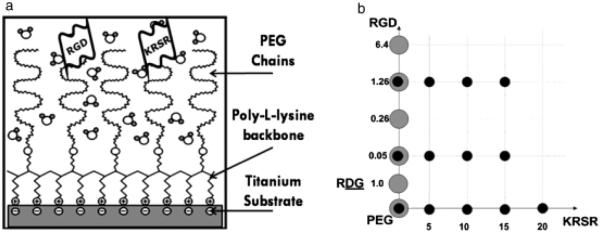Fig. 1.

(a) Schematic of peptide-functionalized poly-L-Lysine grafted polyethylene glycol (PLL-g-PEG) following self-assembly on the titanium SLA surface. (b) Array showing the experimental groups used in this study to evaluate the interaction of RGD and KRSR. The large gray dots represent the previous study by Tosatti et al. (Tosatti et al. 2004) while the black dots represent groups used in the present study. Values are measured in pmol/cm2. The dose-dependent response to RGD was measured with the following experimental groups coated on titanium SLA: (4) PLL-g-PEG/PEGRGD(0.05) and (5) PLL-g-PEG/PEG-RGD(1.26). The response to KSSR was measured with the following experimental groups coated on titanium SLA: (6) PLL-g-PEG/PEG-KSSR(10), (7) PLL-gPEG/PEG-RGD(0.05)/PEG-KSSR(10), and (8) PLL-g-PEG/PEG-RGD(1.26)/PEG-KSSR(10). The dose-dependent response to KRSR was measured with the following experimental groups coated on titanium SLA: (9) PLL-g-PEG/PEG-KRSR(5), (10) PLL-g-PEG/PEG-KRSR(10), (11) PLL-g-PEG/PEGKRSR(15), and (12) PLL-g-PEG/PEG-KRSR(20). Multifunctional peptide experimental groups included: (13) PLL-g-PEG/PEG-RGD(0.05)/PEGKRSR(5), (14) PLL-g-PEG/PEG-RGD(0.05)/PEGKRSR(10), (15) PLL-g-PEG/PEG-RGD(0.05)/PEGKRSR(15), (16) PLL-g-PEG/PEG-RGD(1.26)/PEGKRSR(5), (17) PLL-g-PEG/PEG-RGD(1.26)/PEGKRSR(10), and (18) PLL-g-PEG/PEG-RGD(1.26)/ PEG-KRSR(15). KRSR at a surface peptide density of 20 pmol/cm2 was near the saturating surface peptide density and therefore could not be combined with RGD.
